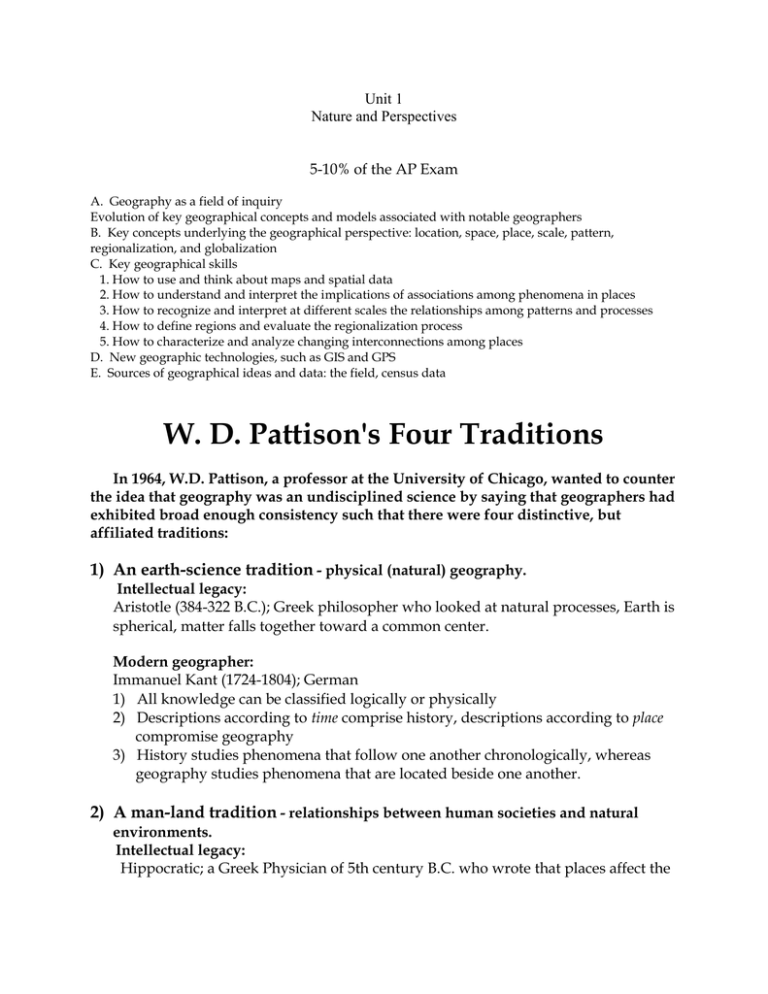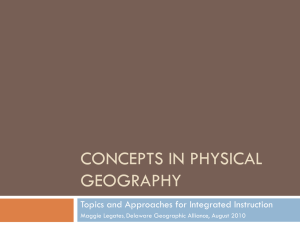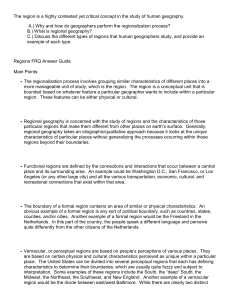2) A man-land tradition
advertisement

Unit 1 Nature and Perspectives 5-10% of the AP Exam A. Geography as a field of inquiry Evolution of key geographical concepts and models associated with notable geographers B. Key concepts underlying the geographical perspective: location, space, place, scale, pattern, regionalization, and globalization C. Key geographical skills 1. How to use and think about maps and spatial data 2. How to understand and interpret the implications of associations among phenomena in places 3. How to recognize and interpret at different scales the relationships among patterns and processes 4. How to define regions and evaluate the regionalization process 5. How to characterize and analyze changing interconnections among places D. New geographic technologies, such as GIS and GPS E. Sources of geographical ideas and data: the field, census data W. D. Pattison's Four Traditions In 1964, W.D. Pattison, a professor at the University of Chicago, wanted to counter the idea that geography was an undisciplined science by saying that geographers had exhibited broad enough consistency such that there were four distinctive, but affiliated traditions: 1) An earth-science tradition - physical (natural) geography. Intellectual legacy: Aristotle (384-322 B.C.); Greek philosopher who looked at natural processes, Earth is spherical, matter falls together toward a common center. Modern geographer: Immanuel Kant (1724-1804); German 1) All knowledge can be classified logically or physically 2) Descriptions according to time comprise history, descriptions according to place compromise geography 3) History studies phenomena that follow one another chronologically, whereas geography studies phenomena that are located beside one another. 2) A man-land tradition - relationships between human societies and natural environments. Intellectual legacy: Hippocratic; a Greek Physician of 5th century B.C. who wrote that places affect the health and character of man. Modern geographer(s): Alexander von Humboldt (1769-1859) and Carl Ritter (1779-1859); German 1) Move beyond describing earth’s surface to explaining why certain phenomena are present or absent. 2) Origin of “where” and “why” approach 3) Environmental determinism – how the physical environment causes social development 3) A spatial tradition - spatial unifying theme, similar patterns between physical & human geography. Intellectual legacy: Claudius Ptolemy (A.D. 100?-170?); a Greek, who wrote 8-volume Geographia in the second century A.D. containing numerous maps (also father of geometry). Modern geographer: Alfred Wegener; climatologist 1) Studied spatial arrangement of landmasses, used geographical and geological evidence 2) Continental drift – landmasses were once part of supercontinent (plate tectonics) 4) An area-studies tradition - regional geography Intellectual legacy: Strabo (63? B.C.-A.D. 24?); Roman investigator, who wrote a report called Geography, a massive production for the statesmen intended to sum up and regularize knowledge of location and place, their character, and their differentiation. Modern geographer: Carl Sauer (1889-1975); American 1) The work of human geography is to discern the relationships among social and physical phenomena 2) Everything in the landscape is interrelated. 5 Themes of Geography Location, Human/Environmental Interactions, Regions, Place, Movement A study of Geography begins with knowing where things are located on a map. But more important, it requires an understanding of why things are located in particular places, and how those places influence our lives. By using these 5 themes as a basis for understanding geographic information, we can gain a better appreciation of cultural and environmental changes around the world. The first three themes correspond to Pattison's four traditions. Location, human/environmental interactions, and regions continue to anchor the study of geography. Two other themes, place and movement, were added in 1986 by the National Geographic society developed by the Geography Education National implementation Project (GENIP). All places on earth have distinguishing human and physical characteristics. Movement refers to the mobility of people, goods, and ideas. Location (position on Earth’s surface) Distribution – various locations of a collection of people or objects Ways to indicate location (position): 1) Maps: best way to show location and demonstrate insights gained through spatial analysis 2) Place-name: a name given to a portion of the Earth’s surface (“Miami”) 3) Site: physical characteristics of a place; climate, water sources, topography, soil, vegetation, latitude, and elevation 4) Absolute location: latitude and longitude (parallels and meridians), mathematical measurements mainly useful in determining exact distances and direction (maps) 5) Relative location: location of a place relative to other places (situation), valuable way to indicate location for two reasons: a) Finding an unfamiliar place - by comparing its location with a familiar one (“Miami – 35 miles northwest of Cincinnati”) b) Centrality, understanding its importance (Chicago – hub of sea & air transportation, close to four other states; Singapore – accessible to other countries in Southeast Asia) 6) Distribution: arrangement of something across Earth’s surface a) Density – frequency with which something occurs in an area. Arithmetic density – total number of objects (people) in an area. Physiologic density – number of people per unit area of agriculturally productive land. b) Concentration – extent of a feature’s spread over an area. Clustered – relatively close. Dispersed – relatively far apart. c) Pattern – geometric arrangement of objects. Human/Environmental Interactions (Cultural ecology - relations between cultures and environment) 1) Cultural landscape – includes all human-induced changes that involve the surface and the biosphere. Carl Sauer: “… the forms superimposed on the physical landscape by the activities of man.” 2) Environmental Determinism – human behavior, individually and collectively, is strongly affected by, and even controlled or determined by the environment 3) Possibilism – the natural environment merely serves to limit the range of choices available to a culture 4) Environmental Modification – positive and negative environmental alterations Regions (areas of unique characteristics, ways of organizing people geographically) 1) Distinctive characteristics: a) area: defined spatial extent b) location: lie somewhere on Earth’s surface c) boundaries: sometimes evident on the ground, often based on specifically chosen criteria d) other: cultural (language, religion), economic (agriculture, industry), physical (climate, vegetation) 2) Three types of regions: a) Formal – (a.k.a. uniform, homogeneous), visible and measurable homogeneity (link to scale and detail) b) Functional – product of interactions, and movement of various kinds, usually characterized by a core and hinterland (e.g. a city and its surrounding suburbs) c) Perceptual – (a.k.a. vernacular), primarily in the minds of people (e.g. Sunbelt) 3) Regions can be seen in a hierarchy (vertical order, scale), (e.g. Ft. Lauderdale – Broward County – Florida – Southeastern US …) Place (associations among phenomena in an area) 1) Culture – people’s lifestyles, values, beliefs, and traits a) What people care about: language, religion, ethnicity b) What people take care of: 1) daily necessities of survival (food, clothing, shelter) and 2) leisure activities (artistic expressions, recreation) c) Cultural institutions: political institutions (a country, its laws and rights) 2) Components of culture: a) Culture region – the area within which a particular culture system prevails (dress, building styles, farms and fields, material manifestations,…) b) Culture trait – a single attribute of culture c) Culture complex – a discrete combination of traits d) Culture system – grouping of certain complexes, may be based on ethnicity, language, religion,… e) Culture realm – an assemblage of culture (or geographic) regions, the most highly generalized regionalization of culture and geography (e.g. sub-Saharan Africa) 3) Physical Processes – environmental processes, which explain the distribution of human activities a) Climate – long-term average weather condition at a particular location. Vladimir Koppen’s five main climate regions (expresses humans’ limited tolerance for extreme temperature and precipitation levels) b) Vegetation – plant life. c) Soil – the material that forms Earth’s surface, in the thin interface between the air and the rocks. Erosion and the depletion of nutrients are two basic problems concerning the destruction of the soil. d) Landforms – Earth’s surface features (geomorphology), limited population near poles and at high altitudes Movement (interconnections between areas) 1) Culture Hearths – sources of civilization from which an idea, innovation, or ideology originates (e.g. Mesopotamia, Nile Valley), viewed in the context of time as well as space 2) Cultural diffusion – spread of an innovation, or ideology from its source area to another culture a) Expansion diffusion – an innovation, or ideology develops in a source area and remains strong there while also spreading outward 1) Contagious diffusion – nearly all adjacent individuals are affected (e.g. spread of Islam, disease) 2) Hierarchical diffusion – the main channel of diffusion some segment of those who are susceptible to (or adopting) what is being diffused (e.g. spread of AIDS, use of fax machines) 3) Stimulus diffusion – spread of an underlying principle (e.g. idea of industrialization) b) Relocation diffusion – spread of an innovation, or ideology through physical movement of individuals 1) Migrant diffusion – when an innovation originates somewhere and enjoys strong-but brief-adoption, loses strength at origin by the time it reaches another area (e.g. mild pandemics) 2) Acculturation – when a culture is substantially changed through interaction with another culture 3) Transculturation – a near equal exchange between culture complexes c) Forces that work against diffusion: 1) Time-distance decay – the longer and farther it has to go, the less likely it will get there 2) Cultural barriers – prevailing attitudes or taboos Key Geographical Skills 1. How to use and think about maps and spatial data sets. 2. How to understand and interpret the implications of associations among phenomena in places. 3. How to recognize and interpret at different scales the relationships among patterns and processes. 4. How to define regions and evaluate the regionalization process 5. How to characterize and analyze changing interconnections among places. Place, Space, and Scale Three Parts of the Geographical Perspective: The AP course identifies three key perspectives at the core of the geographical perspective: integration in place, interdependencies between places (space), and interdependencies among scales. Place: place identity – shaped by physical and cultural forces, associations among phenomena in a given area Space: spatial relationships between people, places, and the environment. Scale: truth is scale dependent, phenomena you study at one scale (e.g. local) may well be influenced by developments at other scales (e.g. regional, national, or global) CHAPTER 1. GEOGRAPHY AND HUMAN GEOGRAPHY CHAPTER INTRODUCTION Humans are geographers by nature. They can think territorially or spatially and have an awareness of, and curiosity about the distinctive nature of places. Even children possess qualities of geographers, creating carefully mapped realms in tiny places. Places possess an emotional quality, and we all must belong somewhere. Humans' insatiable curiosity and the place-centered element within us gave birth to geography as an academic discipline. Conquest and commerce generated a need to know about the world and pragmatism was added long ago by traders and explorers. Geography literally means "to describe the Earth," and the practical aspects of geography first arose among the Greeks, Romans, Mesopotamians, and Phoenicians. Divisions Physical and human geography are two great branches of the discipline, and their origins can be traced to the Greeks and later the Romans. Greek scholars were curious about the world, particularly the physical aspects, and collected information from traders and travelers. The Romans, un-like the Greeks, were empire builders and brought many different cultures under their control. They added to the Greek knowledge of the physical Earth and added information about different cultures they encountered or conquered. By the end of the Roman era, theories about a spherical Earth, latitudinal climatic zones, environmental influences on humans, and humans' role in modifying the Earth were established. The latter two are quite significant because today environmental geography is emerging as a link between human and physical geography. Traditions During the twentieth century, geography was marked by four durable traditions: earthscience (physical geography); cultural-environmental (encompasses a wide range of topics with a difficult, even controversial history); locational theory (the spatial focus of the discipline), which has be-come a modern element of human geography; and areaanalysis (primarily involving the description of areas and regions), giving rise to what is today called regional science. These Four Traditions of Geography were first identified in an article by University of Chicago geographer W.D. Pattison in 1964. He argued that these were the four areas where geographic teaching, research, and other activity were concentrated. New Themes In the 1980s, rising concerns about geographic illiteracy in America prompted the National Geo-graphy Society, and several other organizations, to begin campaigns to reintroduce geography into school curricula. In a 1986 publication, the NGS proposed a useful five-theme framework for geography as developed by the Geography Education National Implementation Project (GENIP). Three of the themes correspond to traditions identified earlier: location, human-environment inter-action, and regions. As the fourth tradition, the NGS proposed a single word, place, because all places on the surface of the Earth have distinguishing human and physical characteristics. A fifth theme, movement, refers to the mobility of goods, ideas, and people, an appropriate theme in light of the mobile world we live in today. Maps Maps—graphic representations of all or part of the Earth's surface drawn to scale—are the most important tool of geographers. Maps and geography are practically synonymous, and mapmaking (cartography) is as old as geography itself. The spatial perspective is geography's unifying bond and there is no better way to demonstrate insights gained through spatial analysis than through the use of maps. Maps are our "window on the world." Maps are used to portray the distinctive character of places; their relationship to environmental issues; the movements of people, goods, and ideas; and regions of various types. Maps are used to wage war, make political propaganda, solve medical problems, locate shopping centers, bring relief to refugees, warn of natural hazards—in short, for countless purposes. Maps are not always printed. Everyone has a mental map—a map in their mind— that has developed over years of looking at wall maps, atlas maps, and maps in books, magazines, and newspapers. People’s perception of places and regions is influenced by their individual mental maps as well as printed maps. Since one's perception of different places is a combination of general information, personal experiences, and what is called "hearsay" in the legal profession, that perception is not always accurate. Look carefully at text Figure 1-9 in your text and you will begin to get some idea of the influence that mental maps and perception of places have on people.





